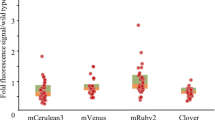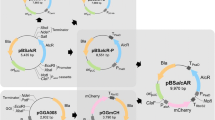Abstract
The choice of strong efficient promoters is a critical step in the development of efficient transformation systems for microalgae; however, the physiological and genetic diversity among microalgae groups makes very difficult to develop standard universal plasmids for a wide number of microalgal species as has been achieved for higher plants. Here, we propose a new approach to express transgenes in microalgae: cotransformation with two naked promoterless genes, a selectable antibiotic-resistant gene and a gene of our interest. These genes are randomly inserted into the nuclear genome, where their transcription relies on their adequate insertion in a region adjacent to an endogenous genomic promoter or in frame with a native gene. In a high percentage of the transformants obtained, both genes are, not only adequately incorporated in the nuclear genome, but also efficiently transcribed and translated. This transformation method is validated in the model microalga Chlamydomonas reinhardtii with the bleomycin-resistant gene from Streptoalloteichus hindustanus (ShBLE) as gene of interest, and it is employed to express a flocculin gene from Saccharomyces bayanus (SbFLO5), which is responsible for the flocculation process in yeasts. Chlamydomonas reinhardtii transformants exhibited self-flocculation abilities between 2- and 3.5-fold higher than the control untransformed strain. The successful cotransformation of C. reinhardtii with two promoterless genes opens doors for the establishment of a universal transformation system based on endogenous promoters, applicable to any microalgal species.






Similar content being viewed by others
References
Alam MA, Wan C, Guo SL, Zhao XQ, Huang ZY, Yang YL, Chang JS, Bai FW (2014) Characterization of the flocculating agent from the spontaneously flocculating microalga Chlorella vulgaris JSC-7. J Biosci Bioeng 118:29–33
Barney MC, Jansen GP, Helber GR (1990) Use of genetic transformation for the introduction of flocculence into yeast. J Am Soc Brew Chem 38:71–74
Benemann J (2013) Microalgae for biofuels and animal feeds. Energies 6:5869–5886
Blanc G, Agarkova I, Grimwood J, Kuo A, Brueggeman A, Dunigan DD, Gurnon J, Ladunga I, Lindquist E, Lucas S, Pangilinan J, Pröschold T, Salamov A, Schmutz J, Weeks D, Yamada T, Lomsadze A, Borodovsky M, Claverie JM, Grigoriev IV, Van Etten JL (2012) The genome of the polar eukaryotic microalga Coccomyxa subellipsoidea reveals traits of cold adaptation. Genome Biol 13:R39
Borowitzka MA (2013) High-value products from microalgae-their development and commercialization. J Appl Phycol 25:743–756
Christou P, Swain WF (1990) Cotransformation frequencies of foreign genes in soybean cell cultures. Theor Appl Genet 79:337–341
Corellou F, Schwartz C, Motta JP, Djouani-Tahri B, Sanchez F, Bouget FY (2009) Clocks in the green lineage: comparative functional analysis of the circadian architecture of the picoeukaryote Ostreococcus. Plant Cell 21:3436–3449
Derelle E, Ferraz C, Rombauts S, Rouzé P, Worden AZ, Robbens S, Partensky F, Degroeve S, Echeynié S, Cooke R, Saeys Y, Wuyts J, Jabbari K, Bowler C, Panaud O, Piégu B, Ball SG, Ral JP, Bouget FY, Piganeau G, De Baets B, Picard A, Delseny M, Demaille J, Van de Peer Y, Moreau H (2006) Genome analysis of the smallest free-living eukaryote Ostreococcus tauri unveils many unique features. Proc Natl Acad Sci U S A 103:11647–52
Díaz-Santos E, De La Vega M, Vila M, Vigara J, León R (2013) Efficiency of different heterologous promoters in the unicellular microalga Chlamydomonas reinhardtii. Biotechnol Prog 29:319–28
Díaz-Santos E, Vila M, De la Vega M, León R, Vigara J (2015) Study of bioflocculation induced by Saccharomyces bayanus var. uvarum and flocculating protein factors in microalgae. Algal Res 8:23–29
Eichler-Stahlberg A, Weisheit W, Ruecker O, Heitzer M (2009) Strategies to facilitate transgene expression in Chlamydomonas reinhardtii. Planta 229:873–883
Enzing C, Sijtsma L, Parisi C, Vigani M, Barbosa M, Ploeg M, Rodriguez Cerezo E (2014) Microalgae-based products for the food and feed sector: an outlook for Europe. JRC Scientific and Policy Reports. Publications Office of the European Union. http://ipts.jrc.ec.europa.eu/publications/pub.cfm?id=7145
Garcia Sánchez R, Solodovnikova N, Wendland J (2012) Breeding of Lager yeast with Saccharomyces cerevisiae improves stress resistance and fermentation performance. Yeast 29:343–55
Georgianna R, Mayfield SP (2012) Exploiting diversity and synthetic biology for the production of algal biofuels. Nature 488:329–335
Goffeau A, Barrell BG, Bussey H, Davis RW, Dujon B, Feldmann H, Galibert F, Hoheisel JD, Jacq C, Johnston M, Louis EJ, Mewes HW, Murakami Y, Philippsen P, Tettelin H, Oliver SG (1996) Life with 6000 genes. Science 274:546–567
Goossens K, Willaert R (2010) Flocculation protein structure and cell–cell adhesion mechanism in Saccharomyces cerevisiae. Biotechnol Lett 32:1571–1585
Govender P, Domingo JL, Bester MC, Pretorius IS, Bauer FF (2008) Controlled expression of the dominant flocculation genes FLO1, FLO5, and FLO11 in Saccharomyces cerevisiae. Appl Environ Microbiol 74:6041–52
Guo SL, Zhao XQ, Wan C, Huang ZY, Yang YL, Alam MA, Ho SH, Bai FW, Chang JS (2013) Characterization of flocculating agent from the self-flocculating microalga Scenedesmus obliquus AS-6-1 for efficient biomass harvest. Bioresour Technol 145:285–9
Harris EH (2009) Chlamydomonas sourcebook: introduction to Chlamydomonas and its laboratory use. 2nd edn (Stern, D. and Witman, G., eds), San Diego, CA, Academic Press.
Hoffman CS, Winston F (1987) A ten-minute DNA preparation from yeast efficiently releases autonomous plasmids for transformation of Escherichia coli. Gene 57:267–272
Jinkerson RE, Jonikas MC (2015) Molecular techniques to interrogate and edit the Chlamydomonas nuclear genome. Plant J 82:393–412
Kathirsesan S, Chandrashekar A, Ravishankar GA, Sarada R (2009) Agrobacterium-mediated transformation in the green alga Haematococcus pluvialis (Chlorophyceae, Volvocales). J Phycol 45:642–649
Kilian O, Benemann CSE, Niyogi KK, Vick B (2011) High-efficiency homologous recombination in the oil-producing alga Nannochloropsis sp. Proc Natl Acad Sci U S A 108:21265–21269
Kindle KL (1990) High-frequency nuclear transformation of Chlamydomonas reinhardtii. Proc Natl Acad Sci U S A 87:1228–1232
Lamesch P, Berardini TZ, Li D, Swarbreck D, Wilks C, Sasidharan R, Muller R, Dreher K, Alexander DL, Garcia-Hernandez M, Karthikeyan AS, Lee CH, Nelson WD, Ploetz L, Singh S, Wensel A, Huala E (2012) The Arabidopsis Information Resource (TAIR): improved gene annotation and new tools. Nucleic Acids Res 40:1202–1210
Larkum AW, Ross IL, Kruse O, Hankamer B (2012) Selection, breeding and engineering of microalgae for bioenergy and biofuel production. Trends Biotechnol 30:198–205
Lee SK, Chou H, Ham TS, Lee TS, Keasling JD (2008) Metabolic engineering of microorganisms for biofuels production: from bugs to synthetic biology to fuels. Curr Opin Biotechnol 19:556–563
León R, Fernández E (2007) Nuclear transformation of eukaryotic microalgae: historical overview, achievements and problems. Adv Exp Med Biol 616:1–11
León R, Couso I, Fernández E (2007) Metabolic engineering of ketocarotenoids biosynthesis in the unicellular microalga Chlamydomonas reinhardtii. J Biotechnol 130:143–152
León-Bañares R, Gonzalez Ballester D, Galvan A, Fernandez E (2004) Transgenic microalgae as green cell-factories. Trends Biotechnol 22:45–52
Loppes R, Radoux M, Ohresser MC, Matagne RF (1999) Transcriptional regulation of the Nia1 gene encoding nitrate reductase in Chlamydomonas reinhardtii: effects of various environmental factors on the expression of a reporter gene under the control of the Nia1 promoter. Plant Mol Biol 41:701–711
Lumbreras V, Stevens DR, Purton S (1998) Efficient foreign gene expression in Chlamydomonas reinhardtii mediated by an endogenous intron. Plant J 14:441–447
Mamedov T, Yusibov V (2011) Green algae Chlamydomonas reinhardtii possess endogenous sialylated N-glycans. FEBS Open Bio 1:15–22
Mathieu-Rivet E, Kiefer-Meyer MC, Vanier G, Ovide C, Burel C, Lerouge P, Bardor M (2014) Protein N-glycosylation in eukaryotic microalgae and its impact on the production of nuclear expressed biopharmaceuticals. Front Plant Sci 5:359
Merchant SS, Prochnik SE, Vallon O et al (2007) The Chlamydomonas genome reveals the evolution of key animal and plant Functions. Science 318:245–250
Prochnik SE, Umen J, Nedelcu AM, Hallmann A, Miller SM, Nishii I, Ferris P, Kuo A, Mitros T, Fritz-Laylin LK, Hellsten U, Chapman J, Simakov O, Rensing SA, Terry A, Pangilinan J, Kapitonov V, Jurka J, Salamov A, Shapiro H, Schmutz J, Grimwood J, Lindquist E, Lucas S, Grigoriev IV, Schmitt R, Kirk D, Rokhsar DS (2010) Genomic analysis of organismal complexity in the multicellular green alga Volvox carteri. Science 329:223–6
Pruess M, Fleischmann W, Kanapin A, Karavidopoulou Y, Kersey P, Kriventseva E, Mittard V, Mulder N, Phan I, Servant F, Apweiler R (2003) The Proteome Analysis database: a tool for the in silico analysis of whole proteomes. Nucleic Acids Res 31:414–417
Radakovits R, Jinkerson RE, Darzins A, Posewitz MC (2010) Genetic engineering of algae for enhanced biofuel production. Eukaryot Cell 9:486–501
Radakovits R, Jinkerson RE, Fuerstenberg SI, Tae H, Settlage RE, Boore JL, Posewitz MC (2012) Draft genome sequence and genetic transformation of the oleaginous alga Nannochloropis gaditana. Nat Commun 21:686
Rasala BA, Mayfield SP (2011) The microalga Chlamydomonas reinhardtii as a platform for the production of human protein therapeutics. Bioeng Bugs 2:50–54
Salim S, Vermuë MH, Wijffels RH (2012) Ratio between autoflocculating and target microalgae affects the energy-efficient harvesting by bio-flocculation. Bioresour Technol 118:49–55
Sambrook J, Russell DW (2001) Molecular cloning: a laboratory manual, 3rd edn. Cold Spring Harbour Laboratory Press, New York
Scaife MA, Nguyen GTDT, Rico J, Lambert D, Helliwell KE, Smith AG (2015) Establishing Chlamydomonas reinhardtii as an industrial biotechnology host. Plant J 82:532–546
Scranton MA, Ostrand JT, Fields FJ, Mayfield SP (2015) Chlamydomonas as a model for biofuels and bio-products production. Plant J 82:523–531
Sizova I, Fuhrmann M, Hegemann P (2001) A Streptomyces rimosus aphVIII gene coding for a new type phosphotransferase provides stable antibiotic resistance to Chlamydomonas reinhardtii. Gene 277:221–229
Steinbrenner J, Sandmann G (2006) Transformation of the green alga Haematococcus pluvialis with a phytoene desaturase for accelerated astaxanthin biosynthesis. Appl Environ Microbiol 72:7477–748
Stevens DR, Rochaix JD, Purton S (1996) The bacterial phleomycin resistance gene ble as a dominant selectable marker in Chlamydomonas. Mol Gen Genet 251:23–30
Talebi AF, Tohidfar M, Tabatabaei M, Bagheri A, Mohsenpor M, Mohtashami SK (2013) Genetici manipulation, as feasible tool to enhance unique characteristic of Chlorella vulgaris as a feedstock for biodiesel production. Mol Biol Rep 40:4421–4428
Tan C, Qin S, Zhang Q, Jiang P, Zhao F (2005) Establishment of a micro-particle bombardment transformation system for Dunaliella salina. J Microbiol 43:361–365
Úbeda-Mínguez P, Chileh T, Dautor Y, García-Maroto F, Alonso DL (2015) Tools for microalgal biotechnology: development of an optimized transformation method for an industrially promising microalga—Tetraselmis chuii. J Appl Phycol 27:223–232
Vanthoor-Koopmans M, Wijffels RH, Barbosa MJ, Eppink MH (2013) Biorefinery of microalgae for food and fuel. Bioresour Technol 135:142–149
Vila M, Couso I, León R (2008) Carotenoids content in mutants of the chlorophyte Chlamydomonas reinhardtii with low expression levels of phytoene desaturase. Process Biochem 43:1147–1152
Vila M, Díaz-Santos E, De la Vega M, Rodríguez H, Vargas A, León R (2012) Promoter trapping in microalgae using the antibiotic paromomycin as selective agent. Mar Drugs 10:2749–2765
Watari J, Kudo M, Nishikawa N, Kamimura M (1990) Construction of flocculent yeast cells (Saccharomyces cerevisiae) by mating or protoplast fusion using a yeast cell containing the flocculation gene FLO5. Agric Biol Chem 54:1677–1681
Wijffels RH, Barbosa MJ (2010) An outlook on microalgal biofuels. Science 329:796–799
Yamamoto QQ, Tsuhara Y, Gohda K, Suzuki K, Matsui M (2003) Gene trapping of the Arabidopsis genome with a firefly luciferase reporter. Plant J 35:273–283
Acknowledgments
We gratefully acknowledge the financial support from the Andalusian Government (P09-CVI-5053 and BIO214) and the CEICAMBIO. Dra. M. Vila thanks the University of Huelva for financial support. We also want to thank Dr. Fernández from the University of Córdoba for critical discussion about the manuscript and Dr. Pérez-Catañeira from the University of Seville for providing protocols and advice for isolation of yeast genomic DNA. We also acknowledge Canvax Biotech (Córdoba, Spain) for technical support on FLO5 cloning. This is 106 publication from CEIMAR Publication Series.
Author information
Authors and Affiliations
Corresponding author
Rights and permissions
About this article
Cite this article
Díaz-Santos, E., Vila, M., Vigara, J. et al. A new approach to express transgenes in microalgae and its use to increase the flocculation ability of Chlamydomonas reinhardtii . J Appl Phycol 28, 1611–1621 (2016). https://doi.org/10.1007/s10811-015-0706-2
Received:
Revised:
Accepted:
Published:
Issue Date:
DOI: https://doi.org/10.1007/s10811-015-0706-2




